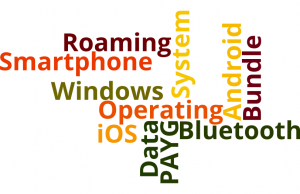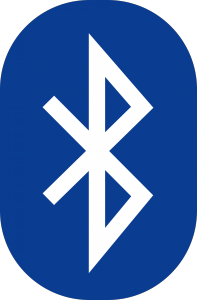IT Jargon Buster: Part 2 – Mobile Phones – Buying
 Buying a mobile phone is always slightly daunting; apart from all the different companies that supply the phones you have network providers, operating systems, various tariffs, data allowance…the list goes on.
Buying a mobile phone is always slightly daunting; apart from all the different companies that supply the phones you have network providers, operating systems, various tariffs, data allowance…the list goes on.
Then comes that dreaded visit to the phone store!
Arm yourself with the jargon before you go so you can pick the best phone for you!
Types of mobile phones
Basic Mobile – most basic mobile phones offer phone calls and text messages only and some of us remember when this was cutting edge!
Smartphones – with a smartphone you can make calls (including video-calls), text, and instant message. They also give you access to the internet so that you can send and receive email, download or stream content such as music, TV programmes or films. You can downloaded apps too, these are ‘tools’ that do a variety of things such as tell you when your next bus or train is due, count your steps, play games or even meditate!
Mobile Operating Systems
An operating system (sometimes abbreviated to OS) is the software that runs a smartphone (or a computer or tablet), there are three main operating systems available:
- Android – developed by Google
- iOS – developed by Apple
- Windows – developed by Microsoft
Operating system preferences are strictly personal – it generally comes down to what you are used to and budget.
Contract or PAYG?
With a mobile contract you are usually paying for the handset and the airtime/ data. Some companies now reduce your bill once your handset itself has been paid for. You will typically be offered a set amount of minutes, texts and mobile data in a contract. Beware – if you ‘go over’ and do not have a safety buffer you will be charged up to 55p per minute on calls and up to 35p per text sent. If you exceed your mobile data, again, charges apply, sometimes as much as £6.50 for every extra 250MB that you use (that’s only one episode of Strictly!).
A SIM only contract is just that, a contract that covers your SIM card and gives you access to calls, texts and data. If you are happy with your handset a cheaper, SIM only, contract might suit. Remember that if you want to change your phone you may have to pay for it all up front.
A PAYG (pay as you go) is just that – you ‘top up’ your phone with credit and use it. The phone itself isn’t included so need to be purchased separately.
What you get

Talk time – this is the amount of minutes that you can use to speak to people in your contract. By using Wi-Fi services like Whatsapp or Skype you can save minutes from your allowance.
Text messages – many people are opting to use free messaging services like WhatsApp and Facebook messenger to send messages via Wi-Fi
Data allowance – the amount of data that allows your mobile phone to access the internet, it is measured in bytes. An average data allowance would be between 500MB up to 5GB. But how much is a MB (MegaByte)? A GB (GigaByte)?
With 250MB you can:
- download or stream 50 songs
- have a seven and a half hour Skype call
- listen to four hours of radio
With 1GB (1ooo MB) you can:
- send 34,133 emails
- watch 68 videos on YouTube
- spend 17 hours on Google Maps
A smartphone contract will typically come with mobile data, the more you want, the more you pay. Some providers allow you to ‘top up’ during the month if you need more. This is generally cheaper than exceeding your data allowance, which can bump up your phone bill a great deal.
Smartphones (and some basic mobile phones) can be connected to the internet via Wi-Fi when available. This saves your mobile data allowances for when you have no Wi-Fi connection.
All those Gs!
1G, 2G, 3G, 4G, 5G – We hear these terms being bandied about by mobile providers but do we really know what they mean? Apparently the bigger the G the better the service.
Here’s a brief history of the G:
1G – (First generation mobile networks) introduced in the 1980s, they were analogue and allowed voice only communication
2G – (Second generation) launched in the 1990s, these digital networks allowed text and picture messages
3G – (Third generation) in the early 2000s 3G led to video calling and mobile data
4G – (Fourth generation) in 2010 we saw 4G which enabled high speed mobile internet for activities like video streaming and gaming
5G – due to arrive in the UK in 2020

Bluetooth
Named after the Tenth Century king of Denmark, Harald Blåtand (which translates to Bluetooth in English), Bluetooth is a way of using a special radio frequency to transfer data. It is a convenient way of sending data from one phone to another which doesn’t use up a data allowance. In order for data to be transferred two or more devices need to be paired. Bluetooth technology is always evolving and now we have Bluetooth headphones, speakers and keyboards (all with no wires!)
SIM card
SIM stands for Subscriber Identity Module. It’s a a small memory chip that is inserted into a mobile phone handset and is required for the phone to talk to the network operator (e.g. Vodafone, o2, etc). When you purchase a mobile phone or sign up to a contract you will be given a SIM card to insert into the phone.
SIM cards allow you to change phones and take your phone number and data plans with you. Some also store contact information; although from personal experience it is difficult to delete contact information from a SIM card so you can end up with lots of phone numbers that you no longer need on each phone you use.
They now also come in different sizes so you will need to check which size your phone uses.
If you are travelling abroad some people recommend buying a PAYG SIM when you arrive at your destination rather than pay roaming charges.

Roaming
Roaming refers to using your phone overseas. When you go abroad your phone will usually connect to a local mobile operator. Recently new EU roaming laws came into force which means that you can use your mobile allowances when in 28 countries in the EU at no extra charge. It’s wise to check which countries these are and, of course, this law may no longer apply after Brexit.
Cameras and Pixels
Mobile phone cameras are graded in pixels – basically (of course it’s far more complicated that this!) the higher the pixel count the better quality pictures your phone will take. If you want to enlarge or print photos then it’s wise to look for a phone with at least an eight megapixel camera.
Most phones now have front and rear cameras so that you can take pictures of a ‘view’ or take a selfie, they also have video recorders.
Photos and video can use a lot of the phone’s memory.
If you are looking for a top-notch camera phone it is worth researching and seeking advice from an impartial phone store.
Memory
Phones come with Internal and Phone storage (memory). The operating system and system files (essentials!) are stored on the internal memory. Many phones come with default apps and these will be stored here too. Unless you’re very techy phone users cannot access this memory.
Downloaded apps, videos, photos etc. are stored on the phone memory. There are limits to how much data you can store on a mobile but this can be increased by using an SD card. This is the equivalent of a USB stick for your phone.
So there you have it, a concise guide to the jargon that you need to know when buying a mobile phone. If you need assistance getting started with your new device why not book a taster session at the Information & Reference Library? Our friendly staff can help!
See also: Safer social networking: Part 1 & Jargon Buster: Part 1
[Library Supervisor]
